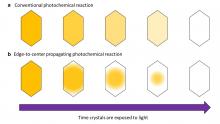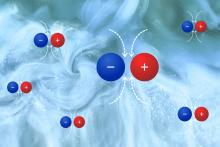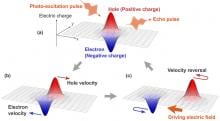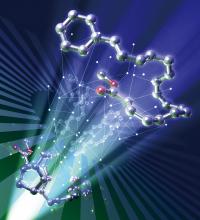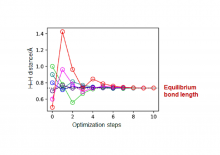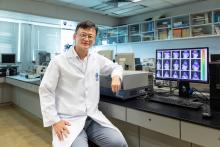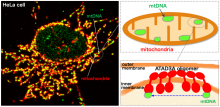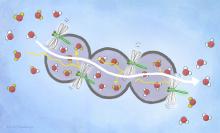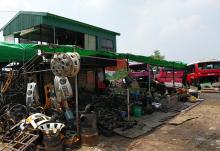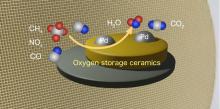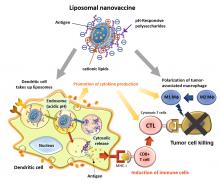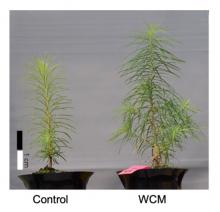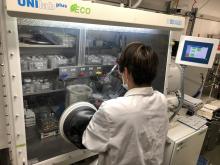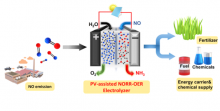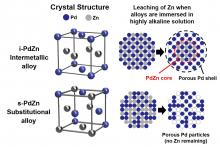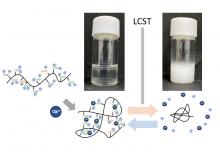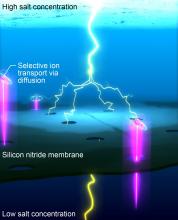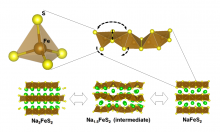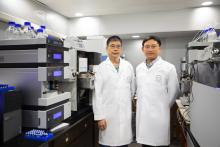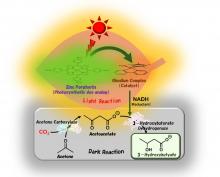Chemistry
News
16 Dec 2022
There is a small area on the electromagnetic spectrum occupied by terahertz waves, where conventional electronic devices struggle to operate. Still, engineering devices that can take advantage of terahertz waves are crucial for the development of future wireless technology such as 6G and 7G. Using a graphene transistor, a research team has successfully detected terahertz waves with a fast response and high sensitivity at room temperature.
15 Dec 2022
Understanding how bats tolerate viral infections, Material separates water from...water, The virtual sense of touch polished to next level and COVID-19 negatively impacted early-careers and female researchers. Read all in the December's Editor's Choice.
14 Dec 2022
- Time Energy Solution Co., Ltd. develops a general consumer-friendly hydrogen fuel generator (Eco-Friendly Hydrogen Fuel Cell Generator)
- Wins CES 2023 Award for Innovation in ‘Sustainability, Eco Design & Smart Energy’ with ‘Eco-friendly Hydrogen Fuel Cell Generator’
14 Dec 2022
- DGIST Professor Lee Hong-Kyung's joint research team develops convection-induced new concept electrolyte through magnetic nanoparticles, dramatically improving the lifespan of next-generation lithium metal batteries
- Recognized for its excellence, selected as the cover study in the prestigious international journal ‘Advanced Functional Materials’
13 Dec 2022
A research group at Osaka Metropolitan University has discovered that 2,5-distyrylpyrazine (DSP) crystals undergo a unique photoreaction. Normally, photoreactive color changes proceed uniformly throughout photomechanical molecular crystals, so that all parts of each crystal change color at the same time. However, when light shines evenly on a DSP crystal, the photoreaction propagates from edge to center, deviating from conventional photochemistry models. The group found that this phenomenon was caused by a surface effect and a cooperative effect, which make reactivity extremely high for molecules at the crystal’s edge and those adjacent to molecules that have already changed color.
12 Dec 2022
Researchers at The University of Tokyo show how including the effects of the surrounding water during the aggregation of charged particles can improve the accuracy of simulations, which may help elucidate biological self-assembly
01 Dec 2022
Precise control of quantum systems, such as quantum computers, is of great importance for modern quantum science. One way this has been done is via spin echoes. A research group has discovered a new type of echo, labelling them “energy-band echoes.”
01 Dec 2022
Automated reaction path search method predicts accurate stereochemistry of pericyclic reactions using only target molecule structure.
29 Nov 2022
Using a quantum computer, Osaka Metropolitan University researchers utilized quantum logic circuits to directly calculate, in a single calculation, the energy difference between two molecular geometries. The developed method was then applied to execute the molecular geometry optimization of typical molecular systems. On a classical computer, calculations based on the finite difference method require at least two evaluations of the energy for one-dimensional systems, but previous research has shown that a quantum computer can be used to calculate the energy derivatives based on this method in a single calculation. However, quantum circuits relevant to quantum algorithms capable of performing the energy derivative calculations had not been implemented. The research group has successfully created a quantum circuit to calculate the energy derivatives by modifying the quantum circuit used in the previously developed quantum phase difference estimation algorithm.
28 Nov 2022
A Hong Kong Baptist University (HKBU) collaborative research team has synthesised a nanoparticle named TRZD that can perform the dual function of diagnosing and treating glioma in the brain. It emits persistent luminescence for the diagnostic imaging of glioma tissues in vivo and inhibits the growth of tumour cells by aiding the targeted delivery of chemotherapy drugs. The nanoparticle offers hope for the early diagnosis and treatment of glioma, especially cerebellar glioma, which is even harder to detect and cure with existing methods.
18 Nov 2022
Exploring virtual human-agent relationships, A fly protein gives clue for human cancers, Rare earth elements formed in neutron star mergers 💥, One-stop process for hydrogen production. Read all in the November's Editor's Choice plus Upcoming event K4DM KNOWLEDGE MARKETPLACE – Bangkok 2022: Exchanging Ideas for a Democratic Myanmar.
17 Nov 2022
Researchers led by Osaka University have shown that a molecule known as ATAD3A is essential for the movement of genetic material inside cellular substructures called mitochondria. Appropriate distribution of this DNA, organized into “nucleoid” structures, is key for the generation of energy by the “respiratory chain” protein complex. This study opens up opportunities for developing new methods to alter nucleoid movement and affect mitochondrial function, thereby providing potential therapies against mitochondrial diseases.
14 Nov 2022
Muon non-destructive analysis of Asteroid Ryugu revealed the raw materials of solid matter at the outer regions of the early solar system. The samples contain less oxygen relative to silicon than typical CI chondrites, indicating that previous CI chondrite samples may have been contaminated by terrestrial materials, thus redefining the standard elemental composition of solid materials in the solar system.
09 Nov 2022
A flipping action in a porous material facilitates the passage of normal water to separate it out from heavy water.
08 Nov 2022
Comprehensive characterization of halogenated flame retardants and organophosphate esters in settled dust from informal e-waste and end-of-life vehicle processing sites
08 Nov 2022
With the shift to electric cars a cumbersome process, improvements to exhaust gas purification in petrol or diesel cars are crucial in the fight to reduce emissions. A research group at Tohoku University’s Graduate School of Engineering has developed a Cerium-Zirconium-based oxide that boosts the purifying qualities of ceramics inside catalytic converters - a device attached to conventional cars that converts harmful gases to less-toxic pollutants.
03 Nov 2022
Researchers from Osaka University have demonstrated a proof-of-concept for a novel use of artificial intelligence for enzyme engineering that does not require an enzyme’s crystal structure. By analyzing the amino acid sequences of malic enzymes from various living organisms, the researchers identified the amino acids that are pertinent to using different redox cofactors. The results of this work will facilitate retooling enzymes in research laboratories and the biotech industry.
31 Oct 2022
A research group at Osaka Metropolitan University has developed a drug delivery system that activates a strong cellular immune response to attack cancer cells, using one-tenth of the amount of antigen needed in the group’s previous work. By incorporating positively charged cationic lipids into liposomes and adding negatively charged pH-responsive polysaccharides to the surface, the research group increased the uptake efficiency of liposomes encapsulating cancer antigens by dendritic cells by approximately five times, which increased cytokine production by about 100 times. This increased M1-type macrophages, which activate cancer immunity, and decreased M2-type macrophages, which promote cancer growth.
26 Oct 2022
Plastic sheets coated with an Eu3+ film that converts UV light to red light were able to accelerate growth of vegetal plants and trees.
25 Oct 2022
Making complex polymers with precisely controlled structures becomes much simpler thanks to a new ‘one-pot-and-one-step’ synthesis procedure.
19 Oct 2022
- Design and development of a hybrid core–shell electrocatalyst that converts air pollutants nitric oxide (NO) into ammonia (NH3).
- A strategy to ensure the stability of an electrocatalyst during the NO gas reduction process.
18 Oct 2022
Osaka Metropolitan University researchers have created intermetallic alloy nanoparticles of palladium and zinc with an alternating arrangement of zinc and palladium atoms. The intermetallic alloy is more corrosion-resistant than substitutional alloys while retaining the electrocatalytic properties of both metals, which could be useful for developing new non-precious metal electrocatalysts.
18 Oct 2022
Hydrogen, a clean fuel, is incredibly dense in energy—three times more than diesel or gasoline. Its ability to power a sustainable future has been hindered by a lack of high performing catalysts. Now, a collaborative research group has developed nanoporous molybdenum-based intermetallic compounds that could address this conundrum.
14 Oct 2022
Osaka Metropolitan University scientists have created a novel thermoresponsive polymer by adding divalent cations to polymers and water solvents. They also succeeded in controlling thermoresponsive properties by changing the type and mixing ratio of ionic species. This new polymer type is expected to be applied as an analytical reagent for ion-sensing devices and as a material for drug delivery systems.
13 Oct 2022
The project will apply Indonesia’s Institut Teknologi Bandung's (ITB) specialized expertise in chemical reaction engineering to probe optimization of ammonia firing. Target set on achieving cleaner power generation in Indonesia, based on demonstration testing with H-25 gas turbine.
13 Oct 2022
Giants in History: Japanese chemist Takamine Jokichi (3 November 1854 – 22 July 1922) founded the Tokyo Artificial Fertilizer Company, where he isolated a starch-digesting enzyme (named takadiastase) from the fungus Aspergillus oryzae.
12 Oct 2022
Osaka University researchers developed a power generation system based on osmotic flow of ions through a membrane riddled with tiny nanopores. By optimizing the size and distribution of the pores, the team demonstrated a way to obtain clean energy from the oceans.
11 Oct 2022
Osaka Metropolitan University scientists have successfully developed a new positive electrode material Na2FeS2, consisting of sodium, iron, and sulfur. During testing, batteries using the Na2FeS2 positive electrode had a high energy storage capacity and could be charged and discharged for more than 300 cycles. Because the Na2FeS2 is made of abundant inexpensive elements, it is expected to be used in all-solid-state sodium batteries with higher capacity and lower costs.
10 Oct 2022
A study led by Hong Kong Baptist University (HKBU) has revealed the association between rapidly fading antibody levels in some recovered COVID-19 patients and a high plasma concentration of a metabolite called glycylproline (gly-pro) and its producing enzyme.
03 Oct 2022
Osaka Metropolitan University scientists have successfully synthesized 3-hydroxybutyrate, a raw material for poly-3-hydroxybutyrate (PHB)—a strong, water-insoluble, biodegradable plastic used for packaging materials—from acetone and CO2. With a visible light-driven catalytic system utilizing sunlight and two biocatalysts, the researchers achieved a high conversion yield of about 80%. Mimicking natural photosynthesis, this study artificially reproduced a light reaction involving sunlight and a dark reaction fixing CO2 to synthesize the raw material for PHB. The finding is expected to contribute to solving the plastic waste problem and to reducing CO2.
Events
Sorry, nothing coming up for this discipline
Researchers
Sorry, nothing coming up for this discipline
Giants in history
Sorry, nothing coming up for this discipline





